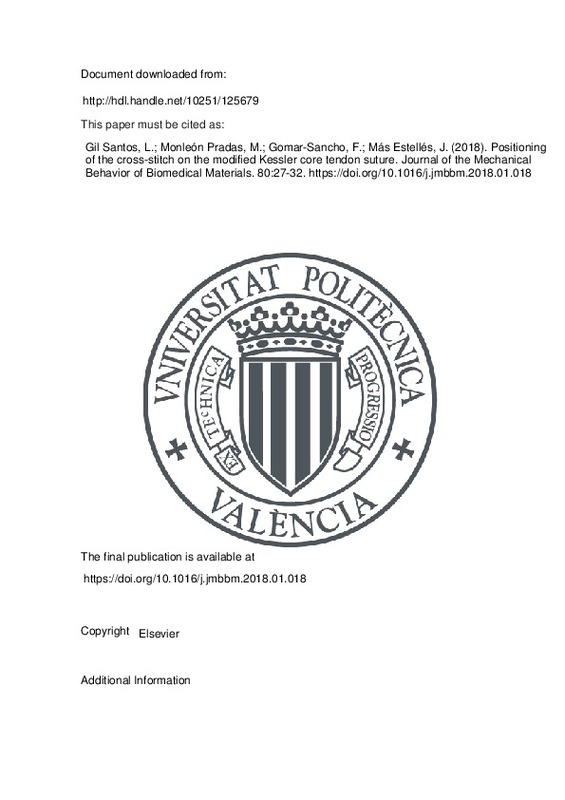JavaScript is disabled for your browser. Some features of this site may not work without it.
Buscar en RiuNet
Listar
Mi cuenta
Estadísticas
Ayuda RiuNet
Admin. UPV
Positioning of the cross-stitch on the modified Kessler core tendon suture
Mostrar el registro sencillo del ítem
Ficheros en el ítem
| dc.contributor.author | GIL SANTOS, LUIS
|
es_ES |
| dc.contributor.author | Monleón Pradas, Manuel
|
es_ES |
| dc.contributor.author | Gomar-Sancho, F.
|
es_ES |
| dc.contributor.author | Más Estellés, Jorge
|
es_ES |
| dc.date.accessioned | 2019-09-14T20:01:15Z | |
| dc.date.available | 2019-09-14T20:01:15Z | |
| dc.date.issued | 2018 | es_ES |
| dc.identifier.issn | 1751-6161 | es_ES |
| dc.identifier.uri | http://hdl.handle.net/10251/125679 | |
| dc.description.abstract | [EN] Cryopreserved human tendons were sutured with different variations of a modified Kessler-type grasping suture in a series of different designs in order to assess the influence of the distance between the cross-stitch on the core suture (5 and 10 mm from the cut tendon edge) on the peripheral suture. An original mathematical model was employed to explain the mechanical behavior (strength, deformation, and distribution of load) of the different suture designs. The effect of the peripheral epitendinous suture, combined with the distance of the core suture, was evaluated. The variation of core suture distance had no relevant consequences on the overall resilience of the design. However, increasing the distance between the cross-stitches of the core suture reduces the deformation that is absorbed not only by the core suture itself but also by the peripheral suture. Adding a peripheral epitendinous suture to a 10-mm design almost doubles the breaking load in absolute values. The mathematical model predicts that the peripheral suture will support a greater load when the distance of the core suture cross-stitches is increased. The evidence level is II. | es_ES |
| dc.language | Inglés | es_ES |
| dc.publisher | Elsevier | es_ES |
| dc.relation.ispartof | Journal of the Mechanical Behavior of Biomedical Materials | es_ES |
| dc.rights | Reserva de todos los derechos | es_ES |
| dc.subject | Biomechanics | es_ES |
| dc.subject | Core and peripheral suture | es_ES |
| dc.subject | Flexor tendon | es_ES |
| dc.subject | Repair | es_ES |
| dc.subject | Resistance | es_ES |
| dc.subject.classification | MAQUINAS Y MOTORES TERMICOS | es_ES |
| dc.subject.classification | FISICA APLICADA | es_ES |
| dc.title | Positioning of the cross-stitch on the modified Kessler core tendon suture | es_ES |
| dc.type | Artículo | es_ES |
| dc.identifier.doi | 10.1016/j.jmbbm.2018.01.018 | es_ES |
| dc.rights.accessRights | Abierto | es_ES |
| dc.contributor.affiliation | Universitat Politècnica de València. Centro de Biomateriales e Ingeniería Tisular - Centre de Biomaterials i Enginyeria Tissular | es_ES |
| dc.contributor.affiliation | Universitat Politècnica de València. Departamento de Termodinámica Aplicada - Departament de Termodinàmica Aplicada | es_ES |
| dc.contributor.affiliation | Universitat Politècnica de València. Departamento de Física Aplicada - Departament de Física Aplicada | es_ES |
| dc.description.bibliographicCitation | Gil Santos, L.; Monleón Pradas, M.; Gomar-Sancho, F.; Más Estellés, J. (2018). Positioning of the cross-stitch on the modified Kessler core tendon suture. Journal of the Mechanical Behavior of Biomedical Materials. 80:27-32. https://doi.org/10.1016/j.jmbbm.2018.01.018 | es_ES |
| dc.description.accrualMethod | S | es_ES |
| dc.relation.publisherversion | https://doi.org/10.1016/j.jmbbm.2018.01.018 | es_ES |
| dc.description.upvformatpinicio | 27 | es_ES |
| dc.description.upvformatpfin | 32 | es_ES |
| dc.type.version | info:eu-repo/semantics/publishedVersion | es_ES |
| dc.description.volume | 80 | es_ES |
| dc.relation.pasarela | S\357245 | es_ES |







![[Cerrado]](/themes/UPV/images/candado.png)

